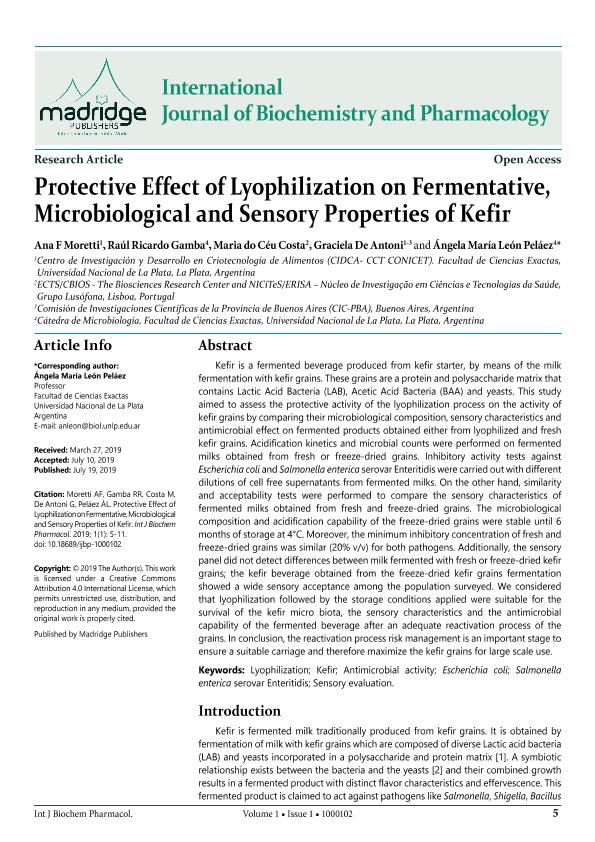Mostrar el registro sencillo del ítem
dc.contributor.author
Moretti, Ana Florencia

dc.contributor.author
Gamba, Raul Ricardo

dc.contributor.author
do Céu Costa, María
dc.contributor.author
de Antoni, Graciela Liliana

dc.contributor.author
León Peláez, Angela Maria

dc.date.available
2020-11-18T18:50:22Z
dc.date.issued
2019-07
dc.identifier.citation
Moretti, Ana Florencia; Gamba, Raul Ricardo; do Céu Costa, María; de Antoni, Graciela Liliana; León Peláez, Angela Maria; Protective Effect of Lyophilization on Fermentative, Microbiological and Sensory Properties of Kefir; Madridge Publishers; International Journal of Biochemistry and Pharmacology; 1; 1; 7-2019; 1-7
dc.identifier.uri
http://hdl.handle.net/11336/118624
dc.description.abstract
Kefir is a fermented beverage produced from kefir starter, by means of the milk fermentation with kefir grains. These grains are a protein and polysaccharide matrix that contains Lactic Acid Bacteria (LAB), Acetic Acid Bacteria (BAA) and yeasts. This study aimed to assess the protective activity of the lyophilization process on the activity of kefir grains by comparing their microbiological composition, sensory characteristics and antimicrobial effect on fermented products obtained either from lyophilized and fresh kefir grains. Acidification kinetics and microbial counts were performed on fermented milks obtained from fresh or freeze-dried grains. Inhibitory activity tests against Escherichia coli and Salmonella enterica serovar Enteritidis were carried out with different dilutions of cell free supernatants from fermented milks. On the other hand, similarity and acceptability tests were performed to compare the sensory characteristics of fermented milks obtained from fresh and freeze-dried grains. The microbiological composition and acidification capability of the freeze-dried grains were stable until 6 months of storage at 4°C. Moreover, the minimum inhibitory concentration of fresh and freeze-dried grains was similar (20% v/v) for both pathogens. Additionally, the sensory panel did not detect differences between milk fermented with fresh or freeze-dried kefir grains; the kefir beverage obtained from the freeze-dried kefir grains fermentation showed a wide sensory acceptance among the population surveyed. We considered that lyophilization followed by the storage conditions applied were suitable for the survival of the kefir micro biota, the sensory characteristics and the antimicrobial capability of the fermented beverage after an adequate reactivation process of the grains. In conclusion, the reactivation process risk management is an important stage to ensure a suitable carriage and therefore maximize the kefir grains for large scale use.
dc.format
application/pdf
dc.language.iso
eng
dc.publisher
Madridge Publishers
dc.rights
info:eu-repo/semantics/openAccess
dc.rights.uri
https://creativecommons.org/licenses/by-nc-sa/2.5/ar/
dc.subject
LYOPHILIZATION
dc.subject
KEFIR
dc.subject
ANTIMICROBIAL ACTIVITY
dc.subject
ESCHERICHIA COLI
dc.subject
SALMONELLA ENTERICA SEROVAR ENTERITIDIS
dc.subject
SENSORY EVALUATION
dc.subject.classification
Biología Celular, Microbiología

dc.subject.classification
Ciencias Biológicas

dc.subject.classification
CIENCIAS NATURALES Y EXACTAS

dc.title
Protective Effect of Lyophilization on Fermentative, Microbiological and Sensory Properties of Kefir
dc.type
info:eu-repo/semantics/article
dc.type
info:ar-repo/semantics/artículo
dc.type
info:eu-repo/semantics/publishedVersion
dc.date.updated
2020-11-18T16:13:40Z
dc.identifier.eissn
2689-7695
dc.journal.volume
1
dc.journal.number
1
dc.journal.pagination
1-7
dc.journal.pais
Portugal

dc.description.fil
Fil: Moretti, Ana Florencia. Provincia de Buenos Aires. Gobernación. Comisión de Investigaciones Científicas. Centro de Investigación y Desarrollo en Criotecnología de Alimentos. Consejo Nacional de Investigaciones Científicas y Técnicas. Centro Científico Tecnológico Conicet - La Plata. Centro de Investigación y Desarrollo en Criotecnología de Alimentos. Universidad Nacional de La Plata. Facultad de Ciencias Exactas. Centro de Investigación y Desarrollo en Criotecnología de Alimentos; Argentina
dc.description.fil
Fil: Gamba, Raul Ricardo. Universidad Nacional de La Plata. Facultad de Ciencias Exactas. Departamento de Ciencias Biológicas. Cátedra de Microbiología General; Argentina. Consejo Nacional de Investigaciones Científicas y Técnicas. Centro Científico Tecnológico Conicet - La Plata; Argentina
dc.description.fil
Fil: do Céu Costa, María. Universidade Lusófona. Escola de Ciências e Tecnologias da Saúde; Portugal
dc.description.fil
Fil: de Antoni, Graciela Liliana. Provincia de Buenos Aires. Gobernación. Comisión de Investigaciones Científicas; Argentina. Provincia de Buenos Aires. Gobernación. Comisión de Investigaciones Científicas. Centro de Investigación y Desarrollo en Criotecnología de Alimentos. Consejo Nacional de Investigaciones Científicas y Técnicas. Centro Científico Tecnológico Conicet - La Plata. Centro de Investigación y Desarrollo en Criotecnología de Alimentos. Universidad Nacional de La Plata. Facultad de Ciencias Exactas. Centro de Investigación y Desarrollo en Criotecnología de Alimentos; Argentina
dc.description.fil
Fil: León Peláez, Angela Maria. Universidad Nacional de La Plata. Facultad de Ciencias Exactas. Departamento de Ciencias Biológicas. Cátedra de Microbiología General; Argentina
dc.journal.title
International Journal of Biochemistry and Pharmacology
dc.relation.alternativeid
info:eu-repo/semantics/altIdentifier/doi/http://dx.doi.org/10.18689/ijbp-1000102
dc.relation.alternativeid
info:eu-repo/semantics/altIdentifier/url/https://tinyurl.com/yymuqwnz
Archivos asociados
